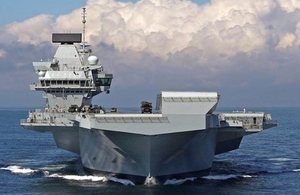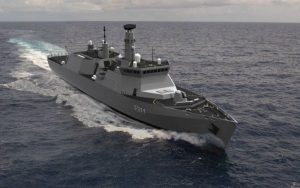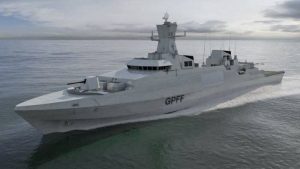2017-09-12 The Aussies last year launched their new shipbuilding strategy.
Now Australia has been joined by the UK officially launched its new strategy.
And this one is informed by a very successful national mobilization effort to deliver modules to a central assembly point and to then put together the largest ship ever built in the United Kingdom.
The Queen Elizabeth class carriers tapped into civilian as well as a defense contracting base to build the new ships.
The UK government envisages something similar for a new class of frigates for the Royal Navy.
According to a story published on the UK Ministry of Defence website on September 6, 2017, the UK MoD has launched a new National Shipbuilding Strategy which sets out plans for the first batch of Type 31e frigates.
Sir John Parker’s independent report into British naval shipbuilding proposed far-reaching recommendations to transform the UK maritime industry and boost the prosperity of regions, shipyards and maritime supply chains across the country.
UK National Shipbuilding Strategy
Today’s Strategy sees the Government accept Sir John’s recommendations and step up to what he called a prospective ‘renaissance’ in British shipbuilding.
Building on the Government’s industrial strategy, it outlines an ambition to transform the procurement of naval ships, make the UK’s maritime industry more competitive, grow the Royal Navy fleet by the 2030s, export British ships overseas, and boost innovation, skills, jobs, and productivity across the UK.
It announces the government’s plan to procure new Type 31e General Purpose Frigates. A price cap has been set of no more than £250M each for the first batch of five frigates.
In line with standing UK policy on warships they will be built in the UK.
They could be built in a way which could see them shared between yards and assembled at a central hub. The first ships are set to be in service by 2023. Shipyards will be encouraged to work with global partners to ensure the vessel is competitive on the export market.
Defence Secretary Sir Michael Fallon said:
“This new approach will lead to more cutting-edge ships for the growing Royal Navy that will be designed to maximise exports and be attractive to navies around the world.
“Backed up by a commitment to spend billions on new ships, our plan will help boost jobs, skills, and growth in shipyards and the supply chain across the UK.
The Strategy sets out the government’s commitment to work with industry to reinvigorate and maximise export success.
The Type 31e will be designed to meet the needs of the Royal Navy and with the export market in mind from the beginning.
This could see industry’s customer become not only the Royal Navy but for the navies of Britain’s allies and partners.
The MOD is committed to new ships for the Royal Navy through its rising budget and £178bn equipment plan.
 HMS Queen Elizabeth, the UK’s new aircraft carrier, which was block built around the country. Credit: UK MoD
HMS Queen Elizabeth, the UK’s new aircraft carrier, which was block built around the country. Credit: UK MoD
In July, at BAE’s Govan shipyard, the Defence Secretary cut steel for the first of eight Type 26 frigates, HMS Glasgow.
The £3.7 billion contract for the first three, the largest for naval ships this decade, will secure hundreds of high skilled jobs on the Clyde until 2035 and hundreds more in the supply chain across the UK.
Sir John Parker said:
“I am very impressed by the courage that the Secretary of State has shown – and the Government – in adopting my recommendations, which were very extensive, and will change the shape of naval shipbuilding over the country in the future.
“The next challenge is to come up with a world-leading design; one that can satisfy the needs of the Royal Navy and the export market. We have the capability to do that, the will is there and it is a tremendous opportunity for UK shipbuilding. I see no reason why industry will not rise to that challenge. There is an incredible keenness from around the country, from Scotland to Merseyside, to the South West and over to Belfast.”
The option to build the Type 31e frigates in blocks reflects how the biggest ship ever built for the Royal Navy, the 65,000-tonne HMS Queen Elizabeth, was constructed.
The aircraft carrier was built in blocks by over 10,000 people in six main British cities. She was then assembled in Rosyth, before commencing sea trials in June and arriving in her home port of Portsmouth last month.
Her sister ship HMS Prince of Wales, built in the same way, is also now structurally complete and will be officially named in a ceremony on 8 September. This method has also been tried and tested on the UK’s new polar research ship, RRS Sir David Attenborough, with shipyards across the country collaborating in the block build.
The Strategy is an important part of the government’s broader industrial strategy that focuses on increasing economic growth across the country and investing in a more skilled workforce.
The Government will work together with industry to provide the certainty and support the need to become internationally competitive.
Such a move will not only boost the British economy and jobs, but it will also help to create a more stable and well-protected world.
https://www.gov.uk/government/news/ambitious-future-for-naval-shipbuilding-in-the-uk
According to the Daily Telegraph in a story written by Alan Tovey, its industry editor on September 6, 2017:
A radical shake-up of how warships will be built for the Royal Navy that aims to spread the work around the country has been unveiled by the Ministry of Defence.
Proposals floated by industrialist Sir John Parker in his review of the sector last year have been backed by Defence Secretary Sir Michael Fallon in a move intended to deliver budget vessels to the British military that are also aimed at being attractive to foreign buyers.
Under the National Shipbuilding Strategy, Britain will buy five “Type 31e” general purpose frigates – a cut-price warship – to bolster the Royal Navy’s depleted fleet, with the first one intended to enter service in 2023.
Sir John recommended the new vessels be built at shipyards around the country, using the “modular” system employed to construct the huge Queen Elizabeth-class aircraft carriers.
 How the new Type 31e frigates might look. Credit: Daily Telegraph
How the new Type 31e frigates might look. Credit: Daily Telegraph
This saw giant blocks fabricated at sites around the UK, before being towed to Rosyth in Scotland were they were integrated into the 65,000-tonne ships by the Aircraft Carrier Alliance, made up of BAE Systems, Babcock and Thales working with the MoD.
Backing his plans could threaten BAE’s near-monopoly on building vessels for the Navy, throwing it open to other entrants to the market, and raising concerns about jobs at the defence giant’s naval operations focused at its Clyde facilities in Glasgow.
Announcing the plan, the MoD said a £250m-per-ship price cap had been set for the vessels, which were revealed in the last defence review when the Government said it would purchase only eight of the more capable Type 26 frigates, with the Type 31 making up numbers.
“This new approach will lead to more cutting-edge ships for the growing Royal Navy that will be designed to maximise exports and be attractive to navies around the world,” the Defence Secretary said, adding the strategy would “help boost jobs, skills, and growth in shipyards and the supply chain across the UK”…..

And a story published on September 6, 2017 in The Financial Times added this detail with regard to the export focus of the program as well:
A shipbuilding strategy, to be unveiled by the Ministry of Defence on Wednesday, will cap the cost of five new warships at no more than £250m each.
Crucially, it will also open the way for the ships — lightweight Type 31e frigates — to be constructed in sections by different companies across the UK, before being assembled at a central hub.
This contrasts with the current position, under which BAE enjoys a monopoly on complex warship building in Britain. Michael Fallon, defence secretary, said the change in approach outlined in the new shipbuilding strategy would “lead to more cutting-edge ships for the growing Royal Navy that will be designed to maximise exports and be attractive to navies around the world”.
He told the BBC on Wednesday morning: “We’ve not exported a new warship in this country for 40 years. We have to get back to making things.”
Unless the U.S. Department of Defense is simply incapable of cross allied procurement learning, there is an obvious opportunity to leverage what the UK and Australia are doing to build a new class of frigates and destroyers.
UK National Shipbuilding Factsheet

